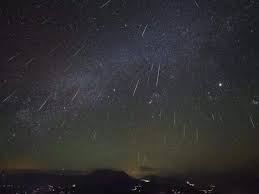News
Top 10 Secrets About Meteor shower
Meteor showers have captivated humanity for centuries, inspiring awe and wonder as streaks of light illuminate the night sky. These celestial displays, caused by debris from comets or asteroids entering Earth’s atmosphere, offer a glimpse into the vastness and beauty of the universe. In this article, we will delve into the top 10 secrets about meteor showers, unraveling the mysteries that make them such mesmerizing spectacles.

- The Origin of Meteor Showers:
Meteor showers occur when the Earth passes through the debris trail left behind by comets or asteroids during their journey around the Sun. As these particles, known as meteoroids, enter our atmosphere, they burn up, producing the radiant trails of light we observe as meteors. - Annual Meteor Showers:
Certain meteor showers are predictable and occur annually at the same time. For example, the Perseids, Geminids, and Leonids are well-known meteor showers that grace our skies each year, providing enthusiasts with ample opportunities for observation. - Radiant Points:
Each meteor shower is associated with a radiant point, the spot in the sky from which the meteors appear to originate. This point is determined by the direction from which the Earth encounters the debris stream. Observing meteors and tracing their paths back to the radiant point adds an extra layer of fascination to the experience. - Meteor Storms:
Occasionally, meteor showers intensify to become meteor storms, where the rate of meteors dramatically increases. These rare events can produce hundreds or even thousands of meteors per hour, transforming the night sky into a breathtaking display of celestial fireworks. - Meteor Shower Naming:
Meteor showers are typically named after the constellation from which their radiant point appears to originate. For instance, the Perseids are named after the constellation Perseus. Understanding the naming conventions adds a sense of astronomical connection to these captivating phenomena. - Parent Bodies:
The parent bodies responsible for meteor showers are often comets, which leave behind a trail of debris as they orbit the Sun. When Earth intersects these trails, we witness the spectacular meteor showers. However, certain meteor showers are associated with asteroid trails as well, highlighting the diverse sources of these cosmic displays. - Meteor Shower Colors:
Most meteors appear as white or yellow streaks across the sky. However, occasionally, observers are treated to vibrant, colorful meteors. These colorful displays occur when the meteoroids contain specific elements that vaporize and ionize upon entry into the atmosphere, creating glowing trails of green, blue, red, or even purple. - Zenithal Hourly Rate (ZHR):
The Zenithal Hourly Rate is a metric used to quantify the meteor shower’s intensity. It represents the number of meteors an observer could see under ideal conditions, with the radiant point directly overhead (zenith). Understanding the ZHR allows enthusiasts to anticipate the peak times and plan their meteor-watching activities accordingly. - Meteor Showers and Wish-Making:
Throughout history and across cultures, people have associated meteor showers with wishes and good luck. The tradition of making wishes upon a shooting star persists to this day, adding a touch of magic and whimsy to these celestial events. - Citizen Science and Meteor Shower Observations:
Meteor showers provide an excellent opportunity for amateur astronomers and citizen scientists to contribute valuable data. Organizations such as the International Meteor Organization (IMO) encourage individuals to observe and report their meteor sightings, helping scientists study and better understand these celestial phenomena.
Meteor showers continue to enchant and inspire stargazers around the world. From their celestial origins to their dazzling displays of light, these cosmic spectacles remind us of the vastness and beauty of the universe. By unraveling the secrets behind meteor showers, we deepen our appreciation for the wonders that grace our night skies, igniting our curiosity about the mysteries that lie beyond our world. So, the next time you witness a meteor shower, take a moment to make a wish and embrace the magic of the cosmos.
